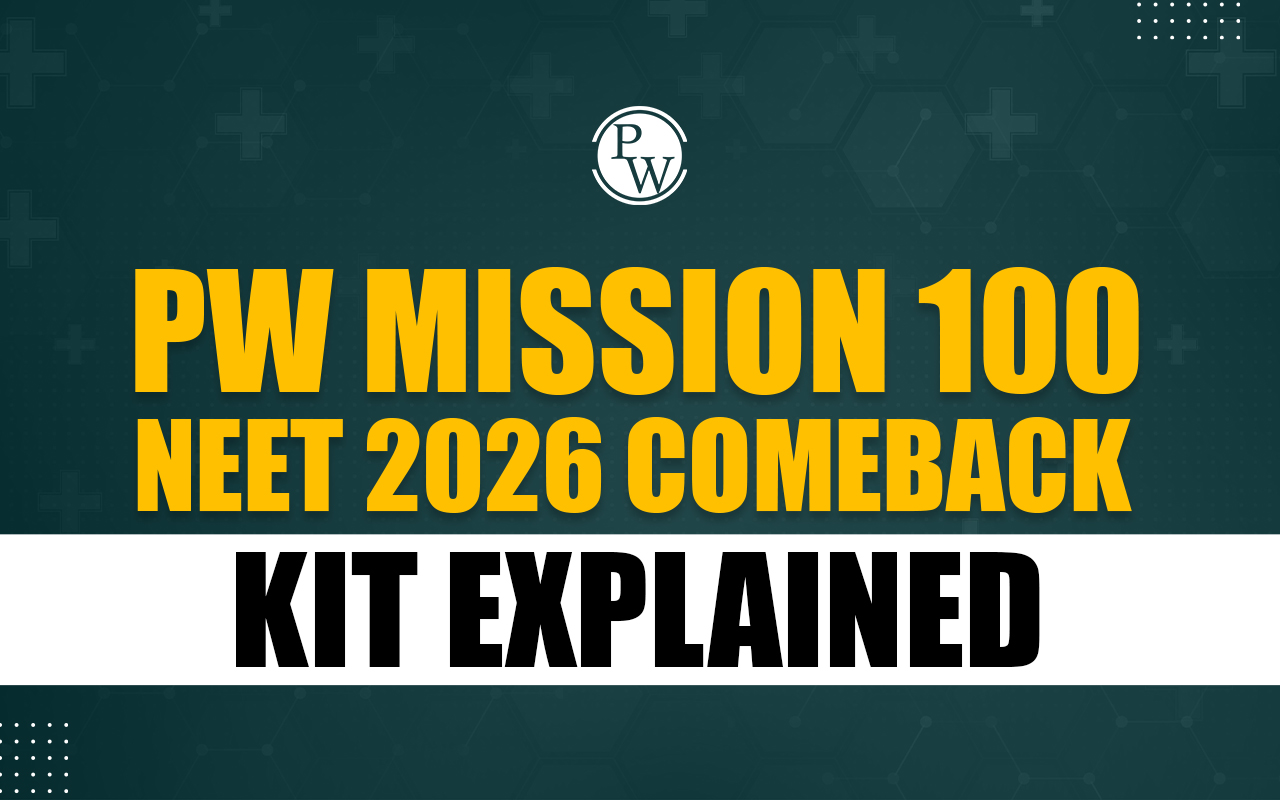
Animal Morphology MCQs: Animal Morphology is an important topic in the NEET biology syllabus and is a part of the Structural Organisation in Animals chapter. This topic has a weightage of 8% in the NEET exam, making it a crucial area of study for students. Understanding animal morphology is essential for solving related MCQs in the exam. Morphology helps us understand the structure, form, and function of different animals. Since this topic holds significant importance, solving MCQs based on it can help students clarify concepts and improve their performance in the NEET exam.
Animal Morphology MCQs Overview
Animal Morphology focuses on the structure, external features, and adaptations of animals. It explains how different animals are built and how their body parts function. Since this topic is often asked in the NEET Exam, students should study it carefully. Referring to chapter-wise NEET biology notes along with solving MCQs will help in better understanding and preparation for the exam.
Download Last 5 Years NEET Previous Year Question Papers PDF
Free NEET PYQ PDF
What is Animal Morphology?
Animal Morphology refers to the study of the shape, size, and structural features of animals. It involves analyzing different organs, tissues, and body parts that help animals survive in their environment. Morphology allows us to classify animals based on their structural similarities and differences. It also plays a key role in understanding evolution, as variations in morphology indicate how species have adapted over time. By studying morphology, we can gain insights into the anatomy of animals and their functional adaptations.
Explore - NEET Online Courses
Animal Morphology MCQs with Explanations
Practicing MCQs on Animal Morphology helps in understanding the structure and function of different animals. It allows students to test their knowledge and improve their problem-solving skills. Since this topic has significant weightage in NEET, solving MCQs is essential for better preparation.
Q1 Read the following statements and find out the incorrect statement.
-
Numerous ommatidia in cockroach eyes provide a mosaic type of vision.
-
In cockroach, brain supplies nerves to antennae and compound eyes.
-
Fat body, nephrocytes and urecose glands also helps in excretion in cockroach.
-
Male cockroach bears one pair of collateral glands which functions as accessory reproductive glands.
Answer: (D)
Explanation: Male cockroach bears one pair of mushroom-shaped glands present in the 6th-7th abdominal segments, which function as accessory reproductive glands.
Q2 Consider the following four statements (i) - (iv) and select the correct option stating which ones are true ( T ) and which ones are false ( F ).
(i) In male cockroach, genital pouch or chamber lies at the hind end of abdomen bounded dorsally by and terga and ventrally by the sternum.
(ii) In cockroach, the haemolymph is composed of colourless plasma and haemocytes.
(iii) In female cockroach, each ovary is formed of a group of ten ovarian tubules or ovarioles, containing a chain of developing ova.
(iv) In cockroach, the nymph grows by moulting about 13 times to reach the adult form.
-
i-F, ii-T, iii-F, iv-T
-
i-F, ii-F, iii-T, iv-T
-
i-T, ii-T, iii-F, iv-T
-
i-T, ii-F, iii-T, iv-F
Answer: (C)
Explanation: In female cockroach, each ovary is formed of a group of eight ovarian tubules or ovarioles, containing a chain of developing ova.
Q3 The given figure shows alimentary canal of cockroach. Identify the parts labelled as A to D and select the correct option.

-
A - Gizzard; B - Crop; C - Hepatic caecae; D Malpighian tubules
-
A - Crop; B - Gizzard; C - Hepatic caecae; D Malpighian tubules
-
A - Crop; B - Gizzard; C - Malpighian tubules; D - Hepatic caecae
-
A - Gizzard; B - Crop; C - Malpighian tubules; D - Hepatic caecae
Answer: (B).
Explanation: The given diagram represents the alimentary canal of a cockroach. The correct identification of parts is A - Crop, B - Gizzard, C - Hepatic caecae, and D - Malpighian tubules. The crop stores food, the gizzard helps in grinding, the hepatic caecae secrete digestive enzymes, and the Malpighian tubules aid in excretion.
Q4 A ring of 6-8 blind tubules present at the junction of foregut and midgut and are called:
-
gastric caecae which secrete digestive juice.
-
hepatic caecae which secrete digestive juice.
-
intestinal caecae which help in grinding the food.
-
both (A) and (B)
Answer: (D)
Explanation: A ring of 6-8 blind tubules called hepatic or gastric caeca is present at the junction of the foregut and midgut, which secretes digestive juice.
Q5 Select the correct option with respect to cockroaches.
-
The fore wings are tegmina which are used in flight.
-
Malpighian tubules convert nitrogenous wastes into urea.
-
Males bear a pair of short, thread like anal styles which are absent in females.
-
Nervous system comprises of a dorsal nervecord and ten pairs of ganglion.
Answer: (C)
Explanation: Malpighian tubules convert nitrogenous wastes into uric acid. A cockroach's nervous system is made up of a double ventral nerve cord and multiple pairs of ganglia. The forewings of a cockroach, called tegmina, are not used for flight.
Q6 Match Column - I with Column - II.
|
Column I |
Column II |
|
|
|
(A) |
Phallomere |
(I) |
Chain of developing ova |
|
(B) |
Gonopore |
(II) |
Bundles of sperm |
|
(C) |
Spermatophore |
(III) |
Opening of the ejaculatory duct |
|
(D) |
Ovarioles |
(IV) |
The external genitalia |
-
A - III, B - IV, C - II, D - I
-
A - IV, B - III, C - II, D - I
-
A-IV, B-II, C-III, D-I
-
A - II, B - IV, C - III, D - I
Answer (B).
Explanation: The external genitalia of cockroaches are known as phallomeres. The gonopore is the opening of the ejaculatory duct. The spermatophore contains bundles of sperm, while ovarioles form a chain of developing ova in the female reproductive system.
Q7 Select the correct statement from the ones given below with respect to Periplaneta americana:
-
grinding of food is carried out only by the mouth parts.
-
nervous system located dorsally, consists of segmentally arranged ganglia joined by a pair of longitudinal connectives.
-
Cockroaches are dioecious and both sexes have well developed reproductive organs
-
there are 16 very long Malpighian tubules present at the junctions of midgut and hindgut.
Answer: (C)
Explanation: The gizzard also helps in grinding the food particles. The nervous system of the cockroach consists of a series of fused, segmentally arranged ganglia joined by paired longitudinal connectives on the ventral side. At the junction of the midgut and hindgut, another ring of 100-150 yellow-colored thin filamentous Malpighian tubules is present.
Q8 Which of the following statements is correct?
-
Tissue is a group of similar cells along with intercellular substances that perform a specific function.
-
Neural tissue exerts least control over the body response.
-
Smooth muscles are voluntary.
-
Skin is dense regular connective tissue.
Answer: (A).
Explanation: A tissue is defined as a group of similar cells working together to perform a specific function. Neural tissue controls the body's responses to external and internal changes. Smooth muscles are involuntary, meaning they cannot be consciously controlled. The skin is composed of dense irregular connective tissue, which provides structural support and flexibility.
Q9 Consider the following statements.
Statement-I: Cardiac muscles are involuntary.
Statement-II: Function of smooth muscle and cardiac muscles are not directly controlled. Choose the correct answer from the options given below:
-
Both Statement-I and Statement-II are correct.
-
Statement-I is correct, but Statement-II is incorrect.
-
Statement-I is incorrect, but Statement-II is correct.
-
Both Statement-I and Statement-II are incorrect.
Answer: (A).
Explanation: Both smooth and cardiac muscles are involuntary, meaning they function without conscious control. Unlike skeletal muscles, which we can contract at will, smooth and cardiac muscle contractions occur automatically to support essential bodily functions like digestion and circulation.
Q10 Which of the following statements are incorrect?
I. Endocrine glands have ducts.
II. Compound epithelium covers the moist surface of the skin.
III. All connective tissue cells secrete fibres of structural proteins called elastin.
IV. The cells of connective tissues, except blood, secrete fibres.
-
Only I and II
-
Only II and III
-
Only I and IV
-
Only I, II and III
Answer: (D).
Explanation: Endocrine glands do not have ducts and release hormones directly into the bloodstream. The compound epithelium lines the dry surface of the skin and moist areas such as the buccal cavity, pharynx, and ducts of glands. In connective tissues (except blood), the cells secrete fibers of proteins like collagen and elastin, which provide structural integrity.
Q11 Which of the following statements are incorrect?
I. Biceps are skeletal muscles.
II. Skeletal muscle fibres are taper at both ends.
III. Cardiac muscles are branched.
-
Only I and II
-
Only II and III
-
III only
-
II only
Answer: (D).
Explanation: Biceps are skeletal muscles, which are voluntary and striated. Smooth muscle fibers taper at both ends, giving them a fusiform shape. Cardiac muscles, found in the heart, are unique in being both striated and branched, allowing for coordinated contraction.
Q12 Which of the following statements about neural tissue is incorrect?
-
Neurons are excitable cells and functional units of the neural system.
-
Neuroglial cells support and protect neurons, constituting more than half of neural tissue.
-
Electrical disturbances in neurons stimulate only adjacent nephrons.
-
Neural tissue controls the body's responsiveness to changing conditions.
Answer: (C).
Explanation: Neurons generate and transmit electrical impulses, influencing various body functions. These impulses do not just stimulate adjacent neurons but can also affect other cells such as muscles and glands. The neural system controls and regulates bodily responses, making it a vital component of physiological coordination.
Q13 All the given statements are correct, except:
-
Among cell junctions, adhering junctions help to stop substances from leaking across a tissue.
-
The stomach and intestine of our body have columnar epithelium.
-
The squamous epithelium is made of a single thin layer of flattened cells.
-
The ciliated epithelial cells are required to move particles or mucus in a specific direction.
Answer: (A).
Explanation: Tight junctions prevent the leakage of substances across tissues, while adhering junctions help in cell adhesion. The stomach and intestine contain columnar epithelium, which aids in absorption and secretion. The squamous epithelium consists of a single thin layer of flattened cells, while ciliated epithelium moves mucus and particles in a specific direction.
Q14 Matrix is present between cells and fibres known as ground substance. The ground substance in most connective tissue is secreted by:
-
mast cells.
-
eosinophil cells.
-
fibroblast cells.
-
monocyte cells.
Answer: (C).
Explanation: In most connective tissues, fibroblast cells secrete the ground substance that provides structural support and helps maintain cellular function. These cells play a crucial role in tissue repair and extracellular matrix formation.
Q15 Cuboidal epithelium with brush border of microvilli is found in:
-
lining of intestine.
-
ducts of salivary glands.
-
proximal convoluted tubule of nephron.
-
stomach.
Answer: (C).
Explanation: The cuboidal epithelium with microvilli is present in the proximal convoluted tubule of the nephron, which increases surface area for absorption. The ducts of salivary glands are lined by compound epithelium, while columnar epithelium lines the stomach and intestine, aiding in digestion and absorption.
Prepare for NEET with PhysicsWallah's NEET online coaching. Learn through easy-to-understand lessons and get help whenever you need it.
Animal Morphology MCQs FAQs
What is morphology in animals?
How does Animal Morphology contribute to taxonomy?
Who is the father of animal morphology?
What are the four morphological characteristics?
What is an example of morphology?










